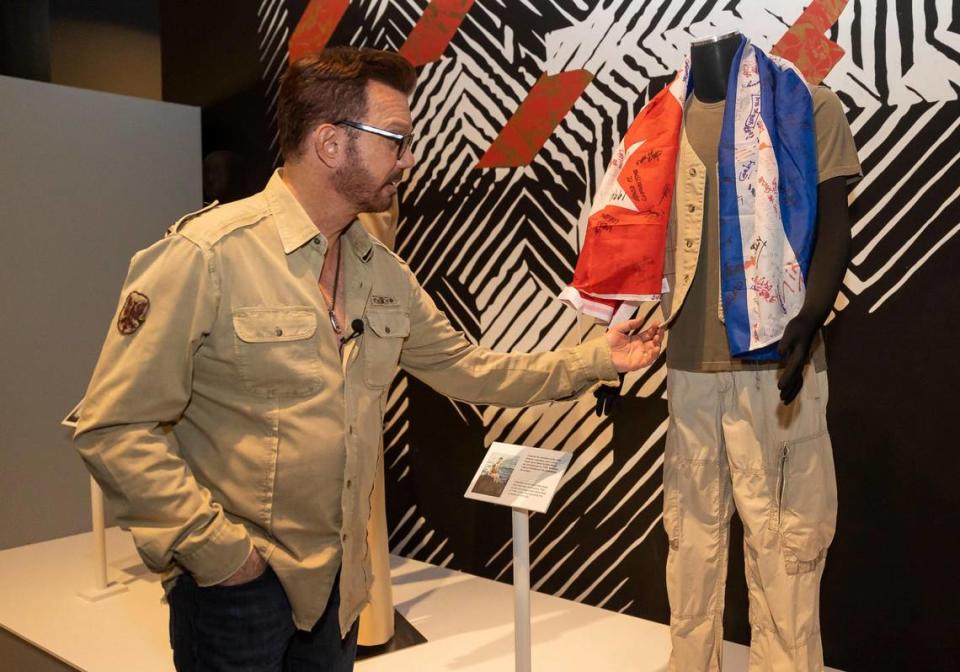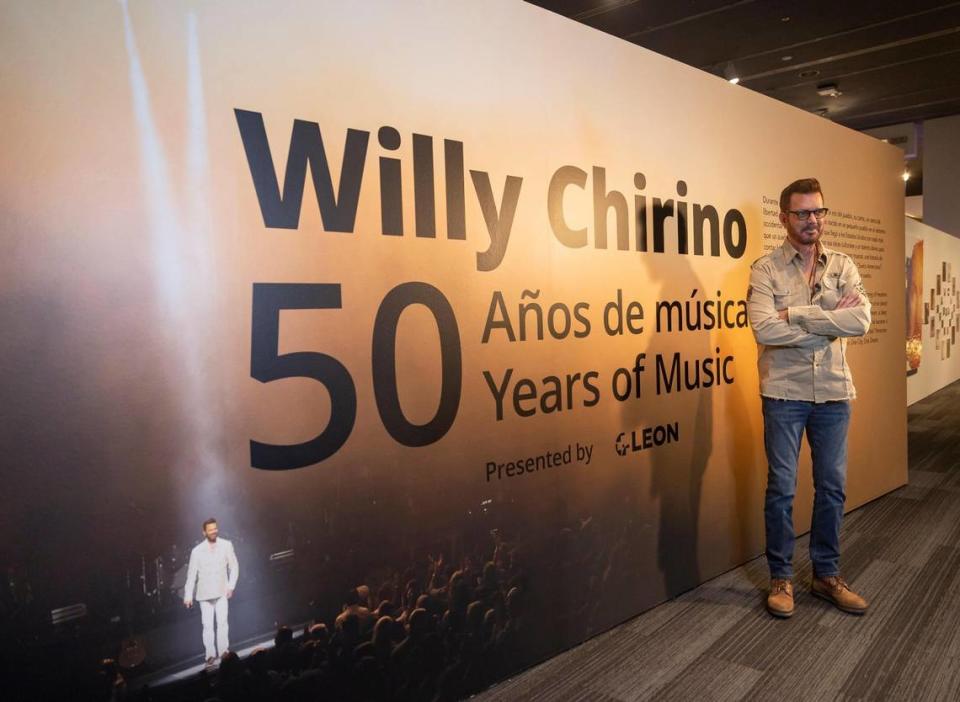Miami museum celebrates the career of this iconic Cuban singer with a huge exhibit
- Oops!Something went wrong.Please try again later.
- Oops!Something went wrong.Please try again later.
Latinos and Miamians take their dancing very seriously. That is why the person who gets them moving has their eternal gratitude. They elevate this person to the ranking of a star and give him or her their hearts. Willy Chirino is one of those stars from Miami and Cuba. Now the HistoryMiami museum inaugurates an exhibition dedicated to his five-decades-long career.
His song “Ya Viene Llegando” shook the island in the 1990s just like the more recent hit “Patria y Vida.” And in Miami, the dancing to songs like ”Soy,” “Oxígeno,” “Medias Negras,” “San Zarabanda,” “Soy Guajiro,” “Lo que está pa’ ti” and “Mister Don’t Touch the Banana” doesn’t stop. As soon as the DJ puts them on, the party heats up. You can see the mischievous looks on dancers’ faces when they warn, “Banana belong’ to Changó.”
On display at HistoryMiami is the evidence of Chirino’s status as a beloved icon: There are the awards he has received in his 50-year career; items of personal value to the singer such as the outfits he and Lissette Alvarez wore on their wedding day; photos of his baptism in his native Pinar del Río province; a snapshot of a young Willy with the band that he formed in the 1960s with a group of recently arrived Cuban boys like him, at the dawn of an exile that no one imagined would last 64 years.

But the most important artifacts of Chirino’s life that are on display are three simple things: a newspaper clipping, a stone and an old wallet. These objects bear witness to the time when Chirino became a hero by saving the lives of two people.
In March 1976 he was passing near a canal in Hialeah and saw a sinking car. It was cold, but without thinking, without taking off his clothes, he rushed to rescue two men trapped inside the car. He tried to break the window with his fists and feet, but it didn’t work. Then someone in the group of gawkers threw a stone at Chirino, which he used to break the glass before the car sank to the bottom of the canal.
“The two people had already gone to the back seat and they had a desperate face that no actor would be able to imitate,” recalled Chirino from an armchair by the wall that leads the way to the room where the stone that the two survivors, Eastern Airlines employees, turned into a prized possession.
“I owe my life to you,” says the sign on the stone enclosed in a glass, which includes the name of the people saved and the gratitude of their family.
“That was the wallet my father had when he died and the only thing he kept in it was a newspaper clipping with the news,” Chirino explained.
“That was what touched his heart the most, that the stone had existed, and that I had done what I did,” Chirino added, indicating that at a moment like that, which caused his father so much pride, “you don’t feel like a hero, you do it instinctively, without thinking twice.”
‘El Balsero Mayor’
Chirino was also a hero to the rafters when he traveled to Guantanamo Naval Base to “rescue” them with his music in 1994.
In that exodus, in which more than 35,000 Cubans escaped from the island in fragile boats, sometimes on truck tires or on boards that could not handle the rough waters of the Florida Straits, his songs — which always speak of freedom — were an inspiration.
In the exhibition, the photo of pieces of wood attests to this. “Congratulations, Chirino,” say the hastily-written words on an empty raft, likely found by the US Coast Guard.
One gets goosebumps imagining the fate of its crew.
A few steps away, a Cuban flag signed by rafters in Guantánamo surrounds the shoulders of the mannequin that displays the clothes that Willy wore at his concert on the base.
“While I was there, which was all day, from early morning until dusk, I kept my cool, greeting everyone. But when I got on the plane [back to Miami], the crying fit was violent,” Chirino said, recounting that the rafters dubbed him “El Balsero Mayor” (The Head Rafter).
“It was the first time that I faced a purely Cuban public, who had not experienced living in other circumstances than the dictatorship,” Chirino said.
His music was prohibited in Cuba, and he had heard many anecdotes of people who were imprisoned and beaten for listening to his songs.

His song “Nuestro día (ya viene llegando)“ from his album Oxígeno (1991) was a hymn for rafters and for the Cubans in Miami who hoped for a change on the island after the end of the Soviet Union.
“Meeting these people who threw themselves into the sea without being sure of reaching lands of freedom, was very beautiful,” Chirino said. He recalled the day that he and Lissette accompanied José Basulto, founder of Brothers to the Rescue, in one of the flights that the organization launched to locate rafters on the ocean.
“Suddenly, in the distance, we saw about six or seven people on a raft. We got closer, and I was deeply moved when I saw that raft, those desperate people inside an infinite sea,” he recalled with a broken voice, “and we couldn’t do anything.”
Since they couldn’t rescue them, the pilots used to drop water and food and notify the authorities to search for them.

Two movies and drums
Chirino admits that he is “a man who cries easily.” He was moved to tears when he explained that the exhibition contains photos from his childhood that he had not even seen.
His sisters compiled them and later delivered them to Gonzalo Rodríguez, his manager, who had a key role in the coordination of “Willy Chirino: 50 Years of Music” with the HistoryMiami museum.
“In Cuba, I was already obsessed with music,” Chirino acknowledged, indicating that two films he saw in his hometown of Consolación del Sur in Pinar del Río — where “there was cinema three times a week” — fueled his interest.
“The story of Gene Krupa, the drummer who invented the drum solo, who was a pioneer in highlighting the drums within the jazz orchestra,” he explained, “and the other, the story of Glenn Miller, who added a clarinet to his saxophone section and made a very peculiar and extraordinary sound.”
Chirino has a vast knowledge of the history of music. His fondness for the Beatles is well known, and his album My Beatles Heart (2011) was dedicated to them. From that project, the museum has on display the Sgt. Pepper-style jacket that Chirino used for the album cover. The jacket was made for him by a very experienced Haitian tailor, who has his workshop in Wynwood, Chirino said.

But before that, Krupa made him a fan of the drums. With some upside-down pots and some sticks from a coat rack, he built his own instrument and imitated the drummers he saw on television or heard on the radio in Consolación del Sur before leaving Cuba in August 1961 under Operation Pedro Pan, in which 14,000 Cuban children emigrated to the United States without their parents.
“I was totally convinced that we were going to stay for six months, learn a little English, and return to Cuba. That was the idea of all of us who left at that time, that’s why it became less painful,” said Chirino, who was 14 years old at the time; a year passed before he would reunite with his parents.
His story was not as traumatic as that of other children in the Pedro Pan exodus, who were sent to faraway places, sometimes to orphanages, he noted, citing as an example the case of his wife Lissette, who was sent to Iowa.
“I stayed in Miami. We lived in a hotel on Biscayne Boulevard. We were 87 children, and Monsignor Bryan Walsh lived with us,” recalled Chirino, who describes the creator of Pedro Pan as “a hero, very devoted to his children.”
“They treated us very well. We went to La Salle [school] and every month they bought us clothes at Sears, which was where the Arsht Center is today. Every Friday they gave us $1.50 for personal expenses, which went a long way,” he recalled.
$75, a fortune for a Cuban teenager
All the practice on his improvised drum set helped Chirino get his first gig. A group of friends from La Salle wanted to form a rock band. They needed a drummer and Chirino claimed that he knew how to play even though he had never stood in front of a real instrument. Chirino convinced the group to play a piece he knew.
“’Wipe Out’ had a small solo that I had practiced,” said Chirino.
While performing with the group from La Salle, he eventually was given the chance to record a song about Mother’s Day at La Fabulosa, one of the pioneering exile radio stations.

But then the best thing came. He received an offer to play at a club on Alton Road in Miami Beach for $75 a week, which was a lot of money for a young man recently arrived from Cuba whose parents didn’t speak English.
The work at night consumed almost all his energy. He would go to bed at 3 or 4 in the morning and then got up early to go to high school, but he couldn’t leave the job. The money he earned had become essential for his family’s survival, said Chirino, who learned to play other instruments to ensure he would always have a job.
Five decades of enjoying music
“The greatest blessing that a human being can have is to earn a living from what they love. That’s why at school I fell asleep and at night I was enjoying what I was doing,” Chirino said.
“Writing songs, playing and receiving the love of the people” for five decades is easy, says Chirino, who still waits for “the muse” at night, when the phones don’t ring and everything is quiet.
“Lissette and I live at night. All my songs have been written at night,” he acknowledged.

At 75, Chirino keeps his figure intact, to the point that all the suits that are in the exhibition fit him well, except for the cream-colored jacket he wore for his wedding with Lissette, he said while walking through the exhibition with the press.
Natalia Crujeiras, executive director of the HistoryMiami Museum, said Chirino’s musical career was “admirable in every way,” and praised his significance for the community as “an artist who has managed to transcend countries and generations.”
“He has connected with Cubans on the island and in Miami, giving them hope in their fight for freedom,” said Crujeiras, who also shared the excitement shown to her by an Uber driver, a young Cuban, who took her to the inauguration of the mural dedicated to Chirino on SW Eighth Street last October.
“This proves his ability to connect with the generations that continue to arrive,” concluded Crujeiras.
Willy Chirino: 50 Years of Music
When: Now through Sept. 10
Where: HistoryMiami, 101 W Flagler St., Miami
Info: historymiami.org.

